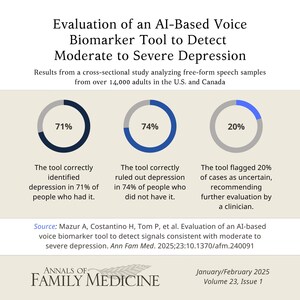Researchers studied implementation of an innovative program to connect high-risk postpartum patients to primary care providers to improve care and reduce risk.
PROVIDENCE, R.I., Jan. 25, 2024 /PRNewswire/ -- In a new article published in Annals of Family Medicine, "A Mixed Methods Evaluation of a Quality Improvement Model to Optimize Perinatal and Primary Care in the Community Health Setting," researchers assessed a quality improvement learning collaborative's (QILC) intervention to link high-risk prenatal patients with primary care. The aims of the study were twofold: to measure the impact of the intervention on postpartum and primary care utilization for high-risk prenatal patients and to explore the Federally Qualified Health Center (FQHC) participants' experiences of working with a QI collaborative.
Using information from patient's health records, 19 clinics within the six participating FQHCs identified high-risk prenatal patients who delivered between January and June 2021. High-risk conditions included pregestational diabetes, gestational diabetes, gestational and chronic hypertension, and depression. The QI intervention implemented a patient registry and conducted direct patient outreach for six months after delivery to connect patients to primary care.
The primary outcome was the change in proportion of high-risk patients with a documented primary care visit within six months postpartum, while the secondary outcome was the change in proportion of patients with a documented postpartum visit within six weeks post-delivery. The former measure increased from 25% to 72%, while the latter went from 83% up to 91%. At the conclusion of the intervention, all six FQHCs had successfully implemented processes for coordinating their maternal and primary care. However, post-implementation, only five chose to continue following the new processes they had developed.
Maternal mortality rates continue to rise across the United States, with non-Hispanic Black birthing people being disproportionately affected—in 2020, they were almost three times more likely to die than non-Hispanic White birthing people. As many deaths occur postpartum, transitioning from prenatal to primary care and remaining engaged in care throughout the first year are critical preventive steps.
The researchers found that, by both quantitative and qualitative measures, FQHC participation in this QILC intervention significantly improved postpartum and primary care utilization for high-risk prenatal patients, albeit with challenges resulting from institutional and structural factors. Greater resources are necessary to ensure sustainability.
An accompanying editorial argues that "future studies must include patient voices as these are the most often overlooked and the most important in the conversation. It is the voices of patients that will illuminate further pragmatic pathways to address the maternal health crisis in the United States and identify ways to improve health outcomes for high-risk pregnant people and their families in the long-term."
Articles Cited:
A Mixed Methods Evaluation of a Quality Improvement Model to Optimize Perinatal and Primary Care in the Community Health Setting
Jena Wallander Gemkow, MPH, BSN, RN, Ashlee Van Schyndel, MPH, Renee M. Odom, MPH, Ananya Stoller, MPH, PMP, Lisa Masinter, MD, MPH, MS, Ta-Yun Yang, MS, Patricia A. Lee King, PhD, MSW, Abigail C. Holicky, MPH and Arden Handler, DrPH, MPH
From Cradle to Grave: Health During Pregnancy and Over a Lifetime.
Carolyn F. Pearce and Mary Beth Sutter
Annals of Family Medicine is a peer-reviewed, indexed research journal that provides a cross-disciplinary forum for new, evidence-based information affecting the primary care disciplines. Launched in May 2003, Annals of Family Medicine is sponsored by seven family medical organizations, including the American Academy of Family Physicians, the American Board of Family Medicine, the Society of Teachers of Family Medicine, the Association of Departments of Family Medicine, the Association of Family Medicine Residency Directors, the North American Primary Care Research Group, and The College of Family Physicians of Canada. Annals of Family Medicine is published online six times each year and contains original research from the clinical, biomedical, social and health services areas, as well as contributions on methodology and theory, selected reviews, essays and editorials. Complete editorial content and interactive discussion groups for each published article can be accessed for free on the journal's website, www.AnnFamMed.org.
SOURCE Annals of Family Medicine

WANT YOUR COMPANY'S NEWS FEATURED ON PRNEWSWIRE.COM?
Newsrooms &
Influencers
Digital Media
Outlets
Journalists
Opted In






Share this article